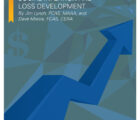
The historic event of the 100th anniversary of the CAS was personally an important and auspicious milestone to me as I assumed the role of CAS President. I very much wanted to commemorate the CAS on this occasion with a piece of art that symbolizes the actuarial endeavors of CAS members. Personally, my artistic skills lack any real training and experience. However, I have lived around artists for much of my life. My late father and my wife, Laurie, definitely have the artistic gift. Laurie and her late mother had worked in stained glass for several years, so I thought that a piece of art in stained glass would be a very nice gift to the CAS. That was the easy part.
After consulting with Laurie and her stained glass art instructor, Mark Kidd, the design of such a piece was a major question. What symbols or visual impressions of actuaries would be appropriate? This certainly required a part of my brain that I don’t use a whole lot. Visually, 100 years of casualty actuarial work — rating formulas, reserve runoff triangles, regression equations, — were not very inspiring for a piece of art. Then I realized that the shapes of probability curves and trend curves might be promising as a visual theme.
The artistic world works very differently than the actuarial world when it comes to getting advice on a design. It was a good thing that I had this crazy art idea many months before the big day, because it was a process of trial and error. I tried a few very crude designs. Then Laurie would take a look and say, “Try something else.” This was not like solving a business or math problem. So, I got a lot better at sketching — first on paper, and then on my iPad.
Alas, my “design” ideas were still lacking a connection to the actuarial world. Curves and the CAS logos were just not enough. My doodling in school and college came back to me — I always liked to draw letters, words, and numbers. Aha! Let me try putting some key actuarial words into the design. After several crude sketches, it seemed to be coming together. And my artistic consultants gave me the thumbs up!
Selecting colors and texture is a real skill — I had no idea what I was doing. Luckily, my artistic consultants were extremely helpful. Of course, now I got to play art critic and say “Try some other colors.” Easier to say than to do, for sure — particularly, since I was doing the recoloring myself on an iPad.
It was very hard for me to imagine what this was going to look like in stained glass. My very simple sketch for the art piece, even with selected colors, seemed to be dull. I had seen Laurie’s sketches for smaller stained glass pieces really come to life as all of the glass pieces were cut, edges foiled in copper, and then soldered together into the final piece. However, her designs were much more traditional, floral and symmetrical.
Luckily, Mark Kidd is a professional stained glass artist and artisan. So, the crafting of the final sketch into a piece of stained glass art was in excellent hands.
As the piece was being completed, I realized that it needed a name. But what did I know about naming a piece of art? Many of my ideas were easily vetoed by my wife. Articles culled from Google searches suggested looking for inspiration within the art. Again, my actuarial training and experience were not particularly helpful. I thought about spending a night under the stars hoping for some inspiration but then thought I would just be up all night in the cold. Then, somehow, I scribbled down a few words, rearranged them, and voilà, “Convergence of Knowledge.”
Convergence of Knowledge is now on display at the CAS office in Arlington, Virginia. Hopefully, some of those who missed seeing the piece in New York may visit the CAS in the future and be able to see it in person. It was a real pleasure, and an interesting journey, to be able to create this gift for the CAS for the years to come.
Bob Miccolis, FCAS, is a director at Deloitte Consulting in Philadelphia.











